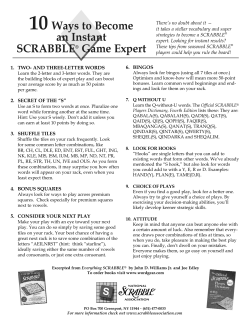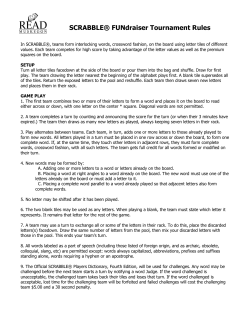
4. New words may be formed by:
4.New words may be formed by: a. Adding one or more letters to a word or letters already on the board. b. Placing a word at right angles to a word already on the board. The new word must use one of the letters already on the board or must add a letter to it. (See Turns 2, 3 and 4 on page 6.) c. Placing a complete word parallel to a word already played so the adjacent letters also form complete words. (See Turn 5 on page 6.) 5.No tile may be shifted or replaced after it has been played and scored. FOR 2 TO 4 PLAYERS / AGES 8+ CONTENTS Gameboard, 100 letter tiles, tile pouch, 4 tile racks, scorebook, and pencil OBJECT In the SCRABBLE® game, players form interlocking words, crossword fashion, on the board using letter tiles of different values. Each player competes for high score by taking advantage of the letter tiles, as well as the premium squares on the board. In a 2-player game, a good player scores in the 300-400 point range. SETUP Place all letter tiles in the pouch, or facedown beside the board, and mix them up. Draw for first play. The player with the letter closest to “A” plays first. A blank tile beats any letter. Return the letters to the pool and remix. All players draw seven new letters each and place them in their racks. GAMEPLAY 1.The first player combines two or more of his or her letters to form a word, and places the word on the board to read either across or down with one letter on the center ★ square. Diagonal words are not allowed. 2.Complete your turn by counting and announcing the score for that turn. Then draw as many new letters as you played, always keeping seven letters on your rack, as long as there are enough left in the pouch. 3.Play passes to the left. The second player, and then each in turn, adds one or more letters to those already played to form new words. All letters played on a turn must be placed in one row across or down the board to form at least one complete word. If, at the same time, they touch other letters in adjacent rows, those must form complete words, crossword fashion, with all such letters. The player gets full credit for all words formed or modified on his or her turn. 1 6. Blanks: The two blank tiles may be used as any letters. When playing a blank, you must state which letter it represents. It remains that letter for the rest of the game. 7.You may use a turn to exchange all, some, or none of your letters. To do this, place your discarded letter(s) facedown. Draw the same number of letters from the pool, then mix your discarded letter(s) into the pool. This ends your turn. 8.Before the game begins, players should agree on which dictionary they will use, in case of a challenge. All words labeled as a part of speech (including those listed of foreign origin, and as archaic, obsolete, colloquial, slang, etc.) are permitted with the exception of the following: words always capitalized, abbreviations, prefixes and suffixes standing alone, words requiring a hyphen or an apostrophe. (4 times the letter count), or tripled and then re-tripled (9 times the letter count). NOTE: The center ★ square is a red square, which doubles the score for the first word. 5.Letter and word premiums count only on the turn in which they are played. On later turns, letters already played on premium squares count at face value. 6.When a blank tile is played on a red or orange square, the value of the word is doubled or tripled, even though the blank itself has no score value. 7.When two or more words are formed in the same play, each is scored. The common letter is counted (with full premium value, if any) for each word. (See Turns 3, 4 and 5 on page 4.) 8.BINGO! If you play seven tiles on a turn, it’s a Bingo. You score a premium of 50 points after totaling your score for the turn. 9. Unplayed Letters: When the game ends, each player’s score is reduced by the sum of his or her unplayed letters. In addition, if a player used all his or her letters, the sum of the other players’ unplayed letters is added to that player’s score. HOW TO WIN The player with the highest final score wins the game. In case of a tie, the player with the highest score before adding or deducting unplayed letters wins. Any play may be challenged before the next player starts a turn. If the play challenged is unacceptable, the challenged player takes back his or her tiles and loses that turn. If the play challenged is acceptable, the challenger loses his or her next turn. All words (not just one) made in one play are challenged simultaneously. If any word is unacceptable, the entire play is unacceptable. Only one turn is lost on any challenge. Consult the dictionary for challenges only. RULES FOR SHORTER GAMEPLAY SCORING Finish Line SCRABBLE Game 9.Ending the Game: The game ends when all letters have been drawn and one player uses his or her last letter, or when all possible plays have been made. 1.The scorekeeper tallies each player’s score, entering it after each turn. The score value of each letter is indicated by a number at the bottom of the tile. The score value of a blank is zero. 2.The score for each turn is the sum of the letter values in each word(s) formed or modified on that turn, plus the additional points obtained from placing letters on premium squares. 3. Premium Letter Squares: A blue square doubles the score of a letter placed on it; a green square triples the letter score. 4. Premium Word Squares: The score for an entire word is doubled when one of its letters is placed on a red square; it is tripled when one of its letters is placed on a orange square. Include premiums for double or triple letter values, if any, before doubling or tripling the word score. If a word covers two premium word squares, the score is doubled and then re-doubled 2 New SCRABBLE game players should find these versions faster and more inviting than the standard version. 9-Tile SCRABBLE Game This variant is identical to the original game except players have 9 tiles on their racks instead of the usual 7. You score a 50-point Bingo bonus for using 7, 8, or all 9 tiles on your rack. In this variant, the game is over when one player reaches a pre-decided score, no matter how many tiles are left. This variant allows mixed play-level groups, as the score needed to win depends on the level of the player (Beginner, Intermediate, or Expert). Here are the points needed to win the game. Beginner Intermediate Expert Two Players Three Players Four Players 70 60 50 120 100 90 200 180 160 If players of the same level are playing, each needs to reach the same score. For example, two Intermediate players would be playing to 120 and four Beginners would each be playing to 50. 3 10 Ways to Become an Instant SCRABBLE ® EXAMPLES OF WORD FORMATION AND SCORING THERE’S NO DOUBT ABOUT IT — IT TAKES A STELLAR VOCABULARY AND SUPER STRATEGIES TO BECOME A SCRABBLE EXPERT. LOOKING FOR INSTANT RESULTS? THESE TIPS FROM SEASONED SCRABBLE PLAYERS COULD HELP YOU RULE THE BOARD! In the following, the words or letters added on five successive turns are shown in bold type. The scores shown reflect the letter R being on the center ★ square. In Turn 1, count HORN; in Turn 2, FARM; in Turn 3, PASTE and FARMS; in Turn 4, MOB, NOT and BE; in Turn 5, BIT, PI and AT. Game Expert 1. TWO- AND THREE-LETTER WORDS 6. BINGO’S 2. SECRET OF THE “S” 7. Q WITHOUT U earn the 2-letter and 3-letter words. They are the building blocks L of expert play and can boost your average score by as much as 50 points per game. se an S to form two words at once. Pluralize one word while U forming another at the same time. Hint: Use your S wisely. Don’t add it unless you can earn at least 8 points by doing so. 3. SHUFFLE TILES huffle the tiles on your rack frequently. Look for some common S ways that letters go together. Some of these are BR, CH, CL, DLE, ED, ENT, EST, FUL, GHT, ING, NK, KLE, MIS, ISM, IUM, MB, MP, ND, NT, PR, PL, RE, STR, TH, UN, IVE and OUS. As you form these combinations, it may surprise you how words will often appear on your rack when you least expect them. 4. BONUS SQUARES lways look for ways to play across premium squares. Check A especially for premium squares next to vowels. 5. CONSIDER YOUR NEXT PLAY ake your play with an eye toward your next play. You can do M so simply by saving some good tiles on your rack. Your best chance of having a great next rack is to save some combination of the letters “AEILNRST” (hint: think “starline”), ideally saving either the same number of vowels and consonants, or just one extra consonant. earn the Q-without-U words. The Official SCRABBLE Players L Dictionary (third edition) lists these: QAT(S), QAID(S), QOPH(S), FAQIR(S), QANAT(S), TRANQ(S), QINDAR(S), QINTAR(S), QWERTY(S), SHEQEL, QINDARKA and SHEQALIM. HO R N 8. LOOK FOR HOOKS F A HO RN M HO R N lways look for Bingo’s (using all 7 tiles at once). Optimism and A know-how will mean more 50-point bonuses. Learn common word beginnings and endings and know how to place them on your rack. “ Hooks” are single letters that you can add to existing words that form other words. We’ve already mentioned the “S hook,” but also look for words you could end with a Y, E, R or D. Example: HAND(Y), PLAN(E), TAME(D, R). 9. CHOICE OF PLAYS fter you find a good play, if you have time, look for a better one. A Always try to give yourself a choice of plays. By exercising your decision-making abilities, you’ll likely develop keener strategic skills. F A HOR N M PA S TE F A HOR N M PA S TE Turn 5: Score 16 Turn 4: Score 16 F A HO RN M Turn 3: Score 25 Turn 2: Score 9 Turn 1: Score 14 F A HOR N MOB PAS TE BIT F A HOR N MO B PAS TE We will be happy to hear your questions or comments about this game. US consumers please write to: Hasbro Games, Consumer Affairs Dept., P.O. Box 200, Pawtucket, RI 02862. Tel: 888-836-7025 (toll free). Canadian consumers please write to: Hasbro Canada Corporation, 2350 de la Province, Longueuil, QC Canada, J4G 1G2. SCRABBLE, the associated logo, the design of the distinctive SCRABBLE brand gameboard, and the distinctive letter tile designs are trademarks of Hasbro in the United States and Canada. ©2008 Hasbro, Pawtucket, RI 02862. All Rights Reserved. TM & ® denote U.S. Trademarks. 04264 10. ATTITUDE eep in mind that anyone can beat anyone else with a certain amount K of luck. Also remember that everyone draws poor combinations of tiles at times, so when you do, take pleasure in making the best play you can. Finally, don’t dwell on your mistakes. Everyone makes them, so go easy on yourself and just enjoy playing! PROOF OF PURCHASE 04264 ® hasbrogames.com 4 5 6 F A HOR M PAS
© Copyright 2025











